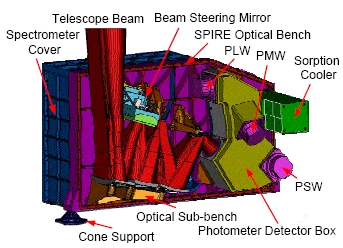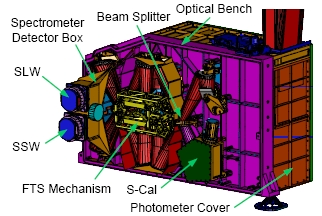





SPIRE is one of three instruments on ESA's Herschel Space Observatory. It featured an imaging photometer and an imaging Fourier transform spectrometer. SPIRE was developed by a consortium of European and American scientists, led by PI Matt Griffin at the Physics and Astronomy Department of Cardiff University.
The U.S. played a crucial role in SPIRE by contributing its detector arrays. These were so-called "spider web bolometers" (PDF) developed by SPIRE Co-I Jamie Bock at JPL. This type of detector was also used by the Planck/HFI, and had been used successfully in many previous experiments—most notably making possible the BOOMERANG detection of anisotropy in the CMB. More detailed information can be found in the SPIRE Observers Manual.
SPIRE was designed primarily to exploit Herschel's capabilities in addressing two of the most prominent questions of modern astrophysics:
how and when did galaxies form? – the investigation of the statistics and physics of galaxy and structure formation at high redshift;
how do stars form? – the study of the earliest phases of star formation, when the protostar is still coupled to the interstellar medium.
These investigations required the ability to carry out deep, large-area, photometric imaging surveys at far-infrared and submillimetre wavelengths, and to follow up these observations with spectroscopy of selected sources.
SPIRE exploited the unique advantages of Herschel: its large-aperture, cold, low-emissivity telescope; the complete lack of atmospheric emission giving access to the poorly explored 194-671 µm range, and the large amount of high-quality observing time. Because of these advantages, SPIRE had an unmatched sensitivity for deep photometry and moderate-resolution spectroscopy.
Although SPIRE was optimized for the two main scientific programs, it offered the astronomical community unique observing capabilities to tackle many other astrophysical topics: giant planets, comets, the galactic interstellar medium, nearby galaxies, ultraluminous infrared galaxies, and active galactic nuclei. Its capabilities have been unchallenged by the ground-based and the airborne observatories that are planned to come into operation over the next decade.




All quoted figures are measurements as of May 2010.